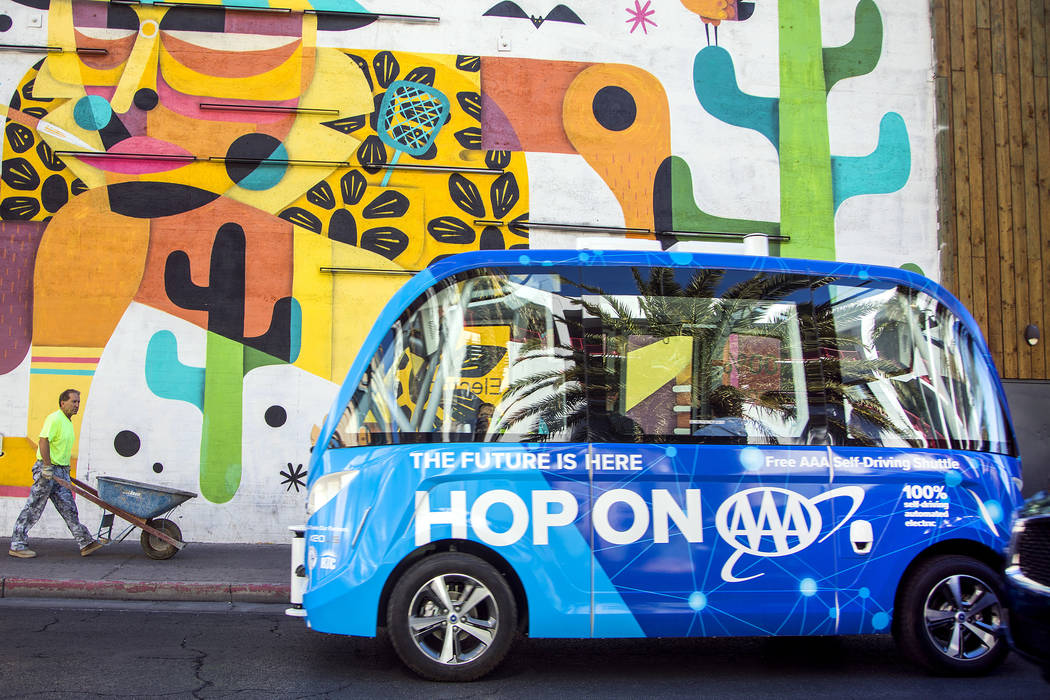Driverless shuttle bringing a glimpse of the future to downtown Las Vegas
Visitors to downtown Las Vegas can take a gamble on the future.
A driverless electric shuttle will hit the streets on Wednesday, capable of “talking” to traffic signals, sharing the road with other vehicles and stopping for pedestrians.
Free rides will be offered aboard the egg-shaped shuttle over the next year, carrying up to 11 passengers along a half-mile loop in the Fremont East neighborhood that was designated last year as part of the city’s “innovation district.”
Magicians Penn and Teller, along with professional race car driver Danica Patrick, are scheduled to appear during a launch event set for 10 a.m. Wednesday in front of the shuttle’s primary stop at Downtown Container Park.
“People look at automobiles as a symbol of freedom and advantage, but it’s amazing to see how much mobility is changing,” said John Moreno, public affairs manager for AAA Nevada.
“We know the general public is skeptical of new technology,” Moreno said. “But hopefully this will build some excitement for what the future of transportation could look like.”
The autonomous shuttle by French company Navya underwent a 10-day test in January, when traffic lanes were blocked along a designated route. This time, the same model shuttle will mingle with other vehicles — a significant move forward in showcasing autonomous technology to the general public.
There are no steering wheels or brake pedals onboard. Instead, the self-driving shuttle will be guided by front and rear cameras, light-detecting sensors, GPS and other technology.
Las Vegas city officials installed wireless sensors that will allow traffic signals to communicate with the shuttle as it travels along varying routes within an area bound by Las Vegas Boulevard and Fremont, Carson and Eighth streets.
The top speed of the shuttle is 25 mph, but it’s expected to scoot through downtown at roughly 10 to 15 mph during the yearlong experiment. A human attendant will be onboard to oversee operations.
Passengers will be asked to rate the ride on a scale of 1 to 5 stars, along with their feelings about autonomous technology. The information will be shared with automakers and government agencies to gauge interest and concerns about driverless vehicles.
“Over the next year, this public-private partnership will help us better understand the customer experience, provide data to further develop intelligent infrastructure, and identify the opportunities and challenges for creating safe and efficient advanced mobility options,” said Tina Quigley, general manager of the Regional Transportation Commission of Southern Nevada.
AAA officials have set an ambitious goal of 250,000 riders over the next year under a partnership with the city of Las Vegas, the Regional Transportation Commission of Southern Nevada and Keolis Transportation.
The agency declined to say how much it’s spending on the yearlong experiment. However, the Auto Club pledged to donate $1 for every passenger who boards the shuttle, with a minimum donation of $100,000 to the Las Vegas Victim’s Fund to assist those affected by the mass shooting on Oct. 1.
“This is the next stage to see if autonomous vehicles have any conflicts with real-time traffic, which will help us determine if this technology can be rolled out on a longer term,” said Jorge Cervantes, chief operations and development officer for the city of Las Vegas.
More than 37,000 people died in motor vehicle crashes nationwide last year — 90 percent of which were caused by human error, AAA officials said, citing federal statistics. Supporters said that autonomous technology could help reduce the number of deaths and injuries coming from car crashes.
As a result, transit planners are taking a closer look at moving away from concrete and pavement for roads, and moving toward the installation of sensors that would allow autonomous vehicles to safely navigate traffic.
“We want to be able to blend these types of vehicles into the overall transit grid,” said Francis Julien, general manager of Keolis Transportation, which operates some of the RTC’s buses.
“Maybe it could be used to go into neighborhoods to pick up passengers, then connect to a main bus or train line,” Julien said. “The possibilities are really endless.”
Contact Art Marroquin at amarroquin@reviewjournal.com or 702-383-0336. Find @AMarroquin_LV on Twitter.
About the Navya Arma Shuttle
— Two-wheel drive
— 15-kilowatt electric motor
— Top speed of 28 mph
— Operating speed of 10 to 15 mph
— Equipped with front and rear cameras, light-detecting sensors and GPS
Source: AAA

















